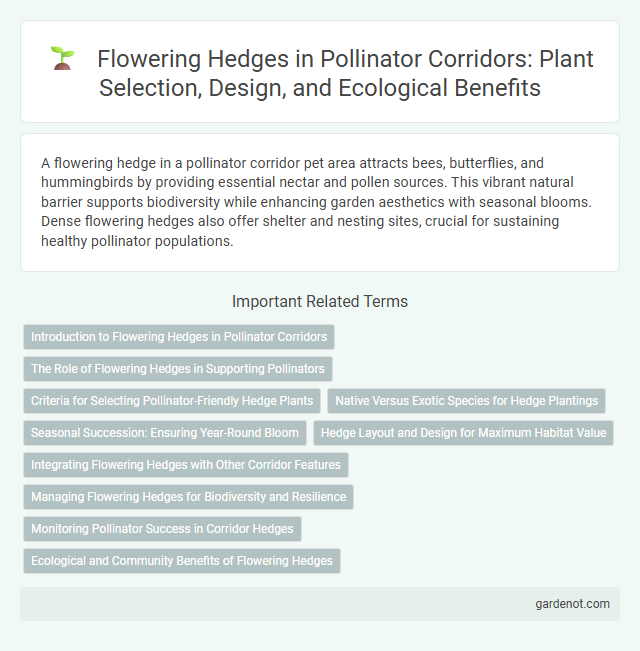A flowering hedge in a pollinator corridor pet area attracts bees, butterflies, and hummingbirds by providing essential nectar and pollen sources. This vibrant natural barrier supports biodiversity while enhancing garden aesthetics with seasonal blooms. Dense flowering hedges also offer shelter and nesting sites, crucial for sustaining healthy pollinator populations.
Introduction to Flowering Hedges in Pollinator Corridors
Flowering hedges play a vital role in pollinator corridors by providing continuous sources of nectar and pollen essential for bees, butterflies, and other pollinators. These hedges, composed of native flowering shrubs and plants, enhance biodiversity and support ecosystem health by offering shelter and foraging habitats throughout the growing season. Integrating flowering hedges into pollinator corridors improves habitat connectivity and promotes sustainable pollination services critical for agriculture and wild plant reproduction.
The Role of Flowering Hedges in Supporting Pollinators
Flowering hedges serve as vital habitats for a wide range of pollinators, providing continuous sources of nectar and pollen throughout the growing season. By offering shelter and nesting sites, these hedges enhance pollinator diversity and abundance, directly supporting ecosystem health and crop productivity. Establishing flowering hedges within pollinator corridors creates essential ecological networks that facilitate pollinator movement and gene flow across fragmented landscapes.
Criteria for Selecting Pollinator-Friendly Hedge Plants
Choosing pollinator-friendly hedge plants involves prioritizing native species with high nectar and pollen production to support local bee and butterfly populations. Plants should provide continuous blooming periods from early spring to late fall to ensure sustained food sources. Selecting diverse species with varied flower shapes and colors enhances habitat suitability for a wide range of pollinators within the corridor.
Native Versus Exotic Species for Hedge Plantings
Flowering hedges composed of native species such as Ceanothus, Mahonia, and Salix offer superior support for pollinators due to their co-evolved relationships with local insects. Exotic species like Leyland cypress or privet may provide greenery but often lack the nectar and pollen resources needed by native pollinators, reducing biodiversity benefits. Prioritizing native plants in pollinator corridors enhances habitat connectivity and sustains native bee populations essential for ecosystem health.
Seasonal Succession: Ensuring Year-Round Bloom
A flowering hedge with seasonal succession provides continuous nectar and pollen sources, supporting diverse pollinator species throughout the year. Selecting native plants that bloom in early spring, summer, and late fall maximizes habitat value and sustains pollinator populations during critical foraging periods. This strategic layering of flowering times enhances biodiversity and strengthens ecosystem resilience.
Hedge Layout and Design for Maximum Habitat Value
A flowering hedge designed with diverse native plant species arranged in staggered rows maximizes habitat value by providing continuous bloom and shelter throughout the seasons. Incorporating a mix of varying heights, bloom times, and structural complexity supports a wide range of pollinators and wildlife. Strategic placement along pollinator corridors enhances connectivity between habitats, promoting biodiversity and ecosystem resilience.
Integrating Flowering Hedges with Other Corridor Features
Integrating flowering hedges with pollinator corridors enhances habitat connectivity by providing continuous floral resources and shelter for bees, butterflies, and other pollinators. Flowering hedges combined with native grasses, wildflower strips, and nesting sites create diverse microhabitats that support pollinator life cycles and increase biodiversity. Strategic placement of flowering hedges along corridors also aids in pest control by attracting beneficial insects, promoting ecosystem resilience.
Managing Flowering Hedges for Biodiversity and Resilience
Managing flowering hedges involves selecting native, nectar-rich plant species that bloom sequentially to support pollinators throughout the seasons. Regular pruning enhances plant vigor and encourages denser flowering, providing continuous habitat and food resources for bees, butterflies, and other pollinators. Integrating flowering hedges within pollinator corridors increases landscape connectivity, promoting biodiversity and ecosystem resilience against environmental stressors.
Monitoring Pollinator Success in Corridor Hedges
Monitoring pollinator success in flowering corridor hedges involves systematic observation and data collection on pollinator species diversity and visitation rates. Regular assessments using standardized protocols help track the health and behavior of key pollinators such as bees, butterflies, and hoverflies within the hedgerows. Data-driven insights guide adaptive management strategies to enhance habitat quality and support pollinator populations effectively.
Ecological and Community Benefits of Flowering Hedges
Flowering hedges provide critical ecological benefits by offering habitat and food resources for pollinators such as bees, butterflies, and other beneficial insects, enhancing biodiversity. These hedges improve ecosystem services like pollination and pest control, which support local agriculture and natural plant communities. Community benefits include promoting environmental awareness, fostering social interaction through shared gardening initiatives, and enhancing urban green spaces for mental well-being.
Flowering hedge Infographic

 gardenot.com
gardenot.com